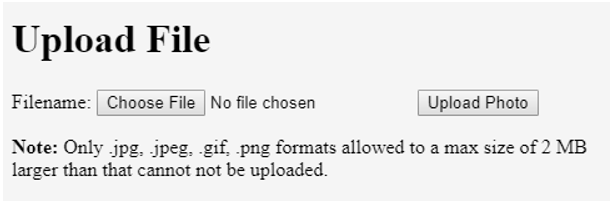Introduction to Upload a File in PHP
In PHP, users can upload files using file upload feature, and the file that has to be submitted through the form and is easily attached and uploaded. The user can upload many types of files may that be document form, image form, pdf form, etc. These kind of files come with an extension i.e. .docx, .jpeg, .pdf, etc. This kind of file is validated by the form and the size of the file is set so that not more than that size is allowed to upload. This is an advanced feature for the user who used to enter data manually is now opting for this option.
How to Create and Upload File in PHP?
With PHP, it is very easy to upload files to the server using a form and the data is also secure compared to others. The configuration file “php.ini” file has a variable that has to be set for the files to be uploaded and it is called “file_uploads” which should be set ON to enable the upload feature. There are a few steps for us to do for uploading a file in the server.
There are few checks before a file gets uploaded to the server using a form. These checks are called validation of the file that is uploaded.
Below are some important points that the developer codes to validate the form:
1. File_uploads
The value of this variable should be ON for the files to be uploaded. If it is not ON then the file cannot be uploaded in the server. So, it should be always ON.
2. Upload Max Size
This directive is used to configure the maximum size of the file that can be uploaded in the server using a form. It is a kind of check done to see the file size of the user uploaded. The default size of the file is set to 2M (two megabytes), and we can overwrite this kind of setting using the .htaccess file where the developer can increase the size of the file. Two megabytes isn’t that much in today’s standards, so we might have to increase this. If you get an error that states that the file size exceeds upload_max_filesize when trying to upload a file, you need to increase the value. If you do, be very sure to also increase post_max_size.
3. Upload_tmp_dir
It sets a temporary directory that will be used to store the uploaded files by the user. In most cases, but we don’t have to worry about this setting. If we don’t set it, the system default will automatically set the temp directory that can be used.
4. Post_max_size
The post_max_size directive allows us to set the maximum size of data uploaded by the POST method. Since files are getting uploaded by POST requests, the value must be greater than what we have set for upload_max_filesize. For example, if the upload_max_filesize is 20M (20 megabytes), we might need to set the post_max_size to 24M.
5. Max_file_uploads
It allows you to set the maximum number of files that can be uploaded by the user at a single go. The default count is 20 for the user at a time.
6. Max_input_time
It’s the number of seconds a script is allowed to parse the input data by the user. We should set it to a reasonable value if we are dealing with a large size of file uploads. 60 (60 seconds) and is a good value for most apps.
7. Memory_limit
The memory limit directive indicates that the maximum amount of memory a script can consume in the server. If we are facing any issues during any upload of large files, we need to set the value of the directive greater than what we have set for the post_max_size directive. By default, the value is set as 128M (128 megabytes), so unless we have a very large post_max_size and upload_max_filesize, we don’t have to worry about it.
8. Max_execution_time
This directive is used for a maximum number of seconds a script is allowed to run in the server. If we are facing any issues during any uploading of large files, we can consider increasing the value to more seconds like 60 (1 minute) and that should work well for most applications.
Examples to Upload File in PHP
Given below are the examples mentioned::
Example #1
Code:
<!DOCTYPE html>
<html>
<body>
<form action="uploadimage.php" method="POST" enctype="multipart/form-data">
Select any image to upload:
<input type="File" name="FileUpload" id="FileUpload">
<input type="submit" value="Upload" name="SUBMIT">
</form>
</body>
</html>Output:
Example #2
Code:
<!DOCTYPE html>
<html lang="en">
<head>
<title>Photo Upload Form</title>
</head>
<body>
<form action="upload.php" method="POST" enctype="multipart/form-data">
<h1>Upload File</h1>
<label for="fileSelect">Filename:</label>
<input type="file" name="photo" id="FileSelect">
<input type="submit" name="SUBMIT" value="Upload Photo">
<p><strong>Note:</strong> Only .jpg, .jpeg, .gif, .png formats allowed to a max size of 2 MB larger than that cannot not be uploaded.</p>
</form>
</body>
</html>Output:
Example #3
Code:
<!DOCTYPE html>
<html>
<body>
<form action="upload.php" method="POST" enctype="multipart/form-data">
Select a file to upload:
<input type="file" name="FileToUpload"/>
<input type="submit" value="Upload" name="submit"/>
</form>
</body>
</html>Output:
Example #4
Code:
<?php
$target_path = "c:/";
$target_path = $target_path.basename( $_FILES['fileToUpload']['name']);
if(move_uploaded_file($_FILES['fileToUpload']['tmp_name'], $target_path)) {
echo "File has been uploaded successfully!";
}
else
{
echo "Sorry, file not uploaded, please check and try again!";
}
?>Output:
In the above examples, the user can see the screen that is present in the snapshots. Users will attach the document by clicking the “choose file” option. The file will get attached once the user selects the file from his local machine and clicks on the Upload button to submit the documents to the server. The user will then be prompted a message stating that the file has been uploaded successfully.
Conclusion
In this article, we discussed how a user can upload a file to the server using the form and how an uploaded file can be validated in various forms, and the server restrictions for uploading a file. The user might not understand the process of the backend but the developer has to code in such a way that the document uploaded by the user should be correct and the data is secured.
Recommended Articles
This is a guide to Upload a File in PHP. Here we discuss the introduction, how to create and upload files in PHP along with different examples and code implementation. You can also go through our other suggested articles to learn more –







